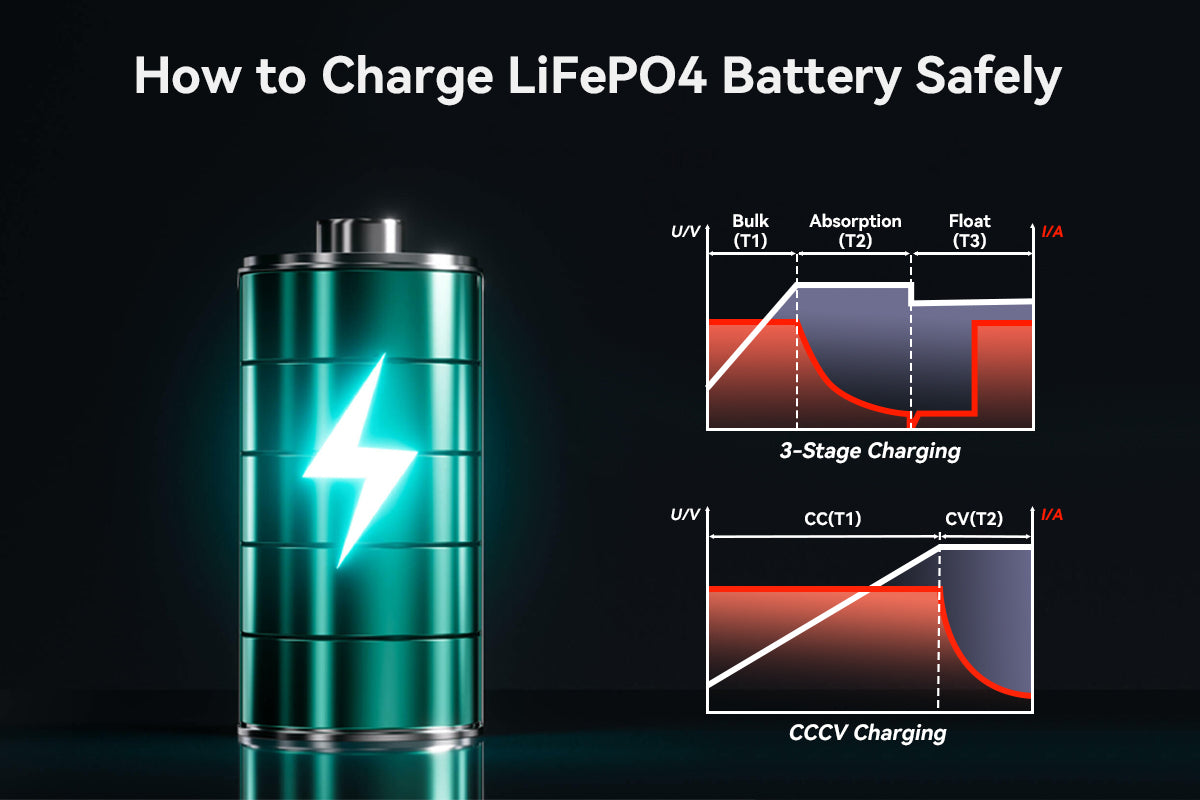แบตเตอรี่ลิเธียมเหล็กฟอสเฟต (LiFePO4) กำลังได้รับความนิยมมากขึ้นเนื่องจากความหนาแน่นพลังงานสูง อายุการใช้งานยาวนาน และคุณสมบัติด้านความปลอดภัย.
คู่มือนี้ให้ภาพรวมเกี่ยวกับ แรงดันแบตเตอรี่ LiFePO4 แนวคิดของ สถานะการชาร์จของแบตเตอรี่ (SOC) และแผนภูมิแรงดันที่สอดคล้องกับสเปคแบตเตอรี่ LiFePO4 ทั่วไป พร้อมกับ ตารางอ้างอิงสำหรับแรงดันแบตเตอรี่และ SOC.
เนื่องจากวิธีการชาร์จของพวกเขาแตกต่างจากแบตเตอรี่ประเภทอื่น โปรดดูที่ บทความแยกต่างหาก ของเราเพื่อรายละเอียดเกี่ยวกับพารามิเตอร์แรงดันไฟฟ้าสำหรับการชาร์จแบตเตอรี่ LiFePO4 ซึ่งครอบคลุม วิธีการชาร์จแบตเตอรี่ LiFePO4 และการกำหนดพารามิเตอร์การชาร์จ อย่างละเอียด.
แบตเตอรี่ LiFePO4 แรงดันไฟฟ้าชื่อ
แรงดันไฟฟ้าชื่อ มักใช้เพื่ออธิบายลักษณะของแบตเตอรี่ ซึ่งทดสอบภายใต้ สภาวะมาตรฐาน: อุณหภูมิ 25°C, การชาร์จ 50% และโหลดปานกลาง แม้ว่าแรงดันไฟฟ้าจริงอาจผันผวนขึ้นอยู่กับระดับการชาร์จ.
เซลล์ LiFePO4 โดยทั่วไปมี แรงดันไฟฟ้าชื่อ 3.2 โวลต์ ซึ่งช่วยในการเปรียบเทียบและออกแบบระบบ อย่างไรก็ตาม เซลล์ LiFePO4 ที่ชาร์จเต็ม อาจมีแรงดันไฟฟ้าประมาณ 3.6 ถึง 3.65 โวลต์ ในขณะที่เซลล์ที่ชาร์จหมดอาจลดลงเหลือประมาณ 2.5 ถึง 2.8 โวลต์ เซลล์เหล่านี้เป็น องค์ประกอบพื้นฐาน ของ แบตเตอรี่ LiFePO4 ใด ๆ.
สำหรับแรงดันไฟฟ้าหรือความจุที่สูงขึ้น เซลล์เหล่านี้จะถูกเชื่อมต่อ แบบอนุกรม (ระบุว่า "s") ซึ่งแรงดันไฟฟ้าของพวกมันจะรวมกัน形成แรงดันไฟฟ้ารวมของแบตเตอรี่แพ็ค.
ตัวอย่างเช่น แบตเตอรี่ LiFePO4 ขนาด 12V ประกอบด้วยเซลล์ 4 เซลล์ต่ออนุกรม (4s) ส่งผลให้มีแรงดันไฟฟ้าชื่อ 12.8V (4 × 3.2V) เมื่อชาร์จเต็ม เซลล์แต่ละเซลล์จะมีแรงดันประมาณ 3.65V ทำให้แรงดันไฟฟ้าที่ชาร์จเต็มของแบตเตอรี่ 12V ประมาณ 14.6V เช่นเดียวกับ แบตเตอรี่แพ็ค 24V ซึ่งมักประกอบด้วยเซลล์ 8 เซลล์ต่ออนุกรม (8s) ส่งผลให้มีแรงดันไฟฟ้าชื่อ 25.6V และเมื่อชาร์จเต็ม แรงดันจะอยู่ที่ประมาณ 29.2V แบตเตอรี่แพ็ค 48V โดยทั่วไปจะใช้เซลล์ 16 เซลล์ต่ออนุกรม (16s) ส่งผลให้มีแรงดันไฟฟ้าชื่อ 51.2V และเมื่อชาร์จเต็มจะมีแรงดันประมาณ 58.4V.
สิ่งสำคัญคือต้องสังเกตความแตกต่างระหว่าง การตั้งค่า 15s และ 16s สำหรับระบบ 48V แพ็ค 15s แม้ว่าจะถูกใช้บางครั้ง มีแรงดันไฟฟ้าชื่อที่ต่ำกว่าที่ 48V (3.2V × 15) โดยมีแรงดันไฟฟ้าที่ชาร์จเต็มประมาณ 54.75V ซึ่งอาจทำให้เกิดปัญหาความเข้ากันได้กับอุปกรณ์บางชนิด การตั้งค่า 16s ที่พบมากกว่ามีแรงดันไฟฟ้าชื่อที่ 51.2V และแรงดันไฟฟ้าที่ชาร์จเต็มประมาณ 58.4V ซึ่งสอดคล้องดีกับอุปกรณ์ 48V มาตรฐาน.
โดยการรวม แบตเตอรี่ในรูปแบบขนานหรืออนุกรม ในกลุ่มแบตเตอรี่ ผู้ใช้สามารถ สร้างระบบสำรองแบตเตอรี่ เพื่อเพิ่มความจุหรือความหนาแน่นของพลังงานที่ต้องการได้มากขึ้น.
สถานะการชาร์จแบตเตอรี่ - SOC คืออะไร
ตรงข้ามกับแบตเตอรี่ Depth of Discharge (DoD) Stage of Charge (SoC) แสดงถึง ระดับการชาร์จที่เหลืออยู่ เป็นเปอร์เซ็นต์ของความจุรวมของแบตเตอรี่ โดยพื้นฐานแล้ว "SoC = 100% - DoD" ตัวอย่างเช่น หากแบตเตอรี่มี DoD ที่แนะนำอยู่ที่ 80% สำหรับอายุการใช้งาน 6000 รอบ หมายความว่าคุณควรชาร์จแบตเตอรี่เมื่อ SoC ของมันลดลงเหลือ 20% หรือต่ำกว่า.
แผนภูมิแรงดันแบตเตอรี่ LiFePO4
แผนภูมิแรงดันไฟฟ้ามักใช้เพื่อติดตามสถานะการชาร์จ (SOC) ของแบตเตอรี่ LiFePO4.
การชาร์จตาม ขั้นตอนการชาร์จแบตเตอรี่ LiFePO4 แรงดันไฟฟ้าจะแตกต่างกันตั้งแต่ การเพิ่มขึ้นอย่างรวดเร็ว ในระยะการชาร์จแบบเต็ม ไปจนถึง การเพิ่มขึ้นที่ช้าลง ในระยะการดูดซับ เมื่อแบตเตอรี่ใกล้จะชาร์จเต็ม แรงดันไฟฟ้าจะ คงที่อยู่ที่ประมาณ 3.6 ถึง 3.7 โวลต์ต่อเซลล์ ตามที่แสดงในกราฟแรงดันไฟฟ้าของแบตเตอรี่ด้านล่าง.

โดยการเปรียบเทียบแรงดันไฟฟ้าของแบตเตอรี่กับแผนภูมิที่ได้มาตรฐาน ผู้ใช้สามารถ ประมาณความจุที่เหลืออยู่ ด้านล่างนี้ เราได้จัดเตรียมแผนภูมิแรงดันไฟฟ้าสำหรับแบตเตอรี่ LiFePO4 ขนาด 12V, 24V และ 48V.
แผนภูมิแรงดันแบตเตอรี่ 12V LiFePO4

| โซซี% | โวลต์ต่อเซลล์ | 12V (4วินาที) |
|---|---|---|
| 100.00% | 3.65 | 14.6 |
| 99.50% | 3.45 | 13.8 |
| 99.00% | 3.38 | 13.52 |
| 90.00% | 3.35 | 13.4 |
| 80.00% | 3.33 | 13.32 |
| 70.00% | 3.30 | 13.2 |
| 60.00% | 3.28 | 13.12 |
| 50.00% | 3.26 | 13.04 |
| 40.00% | 3.25 | 13.00 |
| 30.00% | 3.23 | 12.92 |
| 20.00% | 3.20 | 12.8 |
| 15.00% | 3.05 | 12.2 |
| 9.50% | 3.00 | 12.0 |
| 5.00% | 2.80 | 11.2 |
| 0.50% | 2.54 | 10.16 |
| 0.00% | 2.50 | 10.0 |
แผนภูมิแรงดันแบตเตอรี่ 24V LiFePO4

| โซซี% | โวลต์ต่อเซลล์ | 24V (8วินาที) |
|---|---|---|
| 100.00% | 3.65 | 29.2 |
| 99.50% | 3.45 | 27.6 |
| 99.00% | 3.38 | 27.04 |
| 90.00% | 3.35 | 26.8 |
| 80.00% | 3.33 | 26.64 |
| 70.00% | 3.30 | 26.4 |
| 60.00% | 3.28 | 26.24 |
| 50.00% | 3.26 | 26.08 |
| 40.00% | 3.25 | 26 |
| 30.00% | 3.23 | 25.84 |
| 20.00% | 3.20 | 25.6 |
| 15.00% | 3.05 | 24.4 |
| 9.50% | 3.00 | 24 |
| 5.00% | 2.80 | 22.4 |
| 0.50% | 2.54 | 20.32 |
| 0.00% | 2.50 | 20 |
แผนภูมิแรงดันแบตเตอรี่ 48V LiFePO4

| โซซี% | โวลต์ต่อเซลล์ | 48V (15วินาที) | 51.2V (16วินาที) |
|---|---|---|---|
| 100.00% | 3.65 | 54.75 | 58.4 |
| 99.50% | 3.45 | 51.75 | 55.2 |
| 99.00% | 3.38 | 50.7 | 54.08 |
| 90.00% | 3.35 | 50.25 | 53.6 |
| 80.00% | 3.33 | 49.95 | 53.28 |
| 70.00% | 3.3 | 49.5 | 52.8 |
| 60.00% | 3.28 | 49.2 | 52.48 |
| 50.00% | 3.26 | 48.9 | 52.16 |
| 40.00% | 3.25 | 48.75 | 52 |
| 30.00% | 3.23 | 48.45 | 51.68 |
| 20.00% | 3.2 | 48 | 51.2 |
| 15.00% | 3.05 | 45.75 | 48.8 |
| 9.50% | 3 | 45 | 48 |
| 5.00% | 2.8 | 42 | 44.8 |
| 0.50% | 2.54 | 38.1 | 40.64 |
| 0.00% | 2.5 | 37.5 | 40 |
วิธีตรวจสอบ SoC และแรงดันไฟฟ้าของแบตเตอรี่ LiFePO4
การใช้แบตเตอรี่กับจอภาพ
แบตเตอรี่ LiFePO4 บางรุ่น เช่น PowMr แบตเตอรี่ 51.2v มักมาพร้อมกับ จอแสดงผลและตัวบ่งชี้ในตัว ที่แสดงทั้งแรงดันไฟฟ้าและสถานะการชาร์จ (SoC) ฟีเจอร์นี้ช่วยให้คุณสามารถตรวจสอบสถานะของแบตเตอรี่ได้อย่างรวดเร็วและง่ายดายโดยไม่ต้องใช้เครื่องมือเพิ่มเติม เพียงแค่ดูข้อมูลบนหน้าจอ ซึ่งให้ข้อมูลแบบเรียลไทม์เกี่ยวกับประสิทธิภาพของแบตเตอรี่ของคุณ.
การใช้มัลติมิเตอร์
ในการวัดแรงดันไฟฟ้าเปิดวงจรของแบตเตอรี่ LiFePO4 โดยใช้มัลติมิเตอร์ ให้ทำตามขั้นตอนเหล่านี้เพื่อให้ได้ผลลัพธ์ที่ค่อนข้างแม่นยำ โปรดทราบว่าคุณจะต้อง ถอดการเชื่อมต่อโหลดและชาร์จทั้งหมด และปล่อยให้แบตเตอรี่พัก
เริ่มต้นโดยการถอดโหลดและที่ชาร์จที่เชื่อมต่อกับแบตเตอรี่ หลังจากนั้น รอเป็นเวลา 15-30 นาที เพื่อให้แบตเตอรี่มีเสถียรภาพ จากนั้นให้ใช้มัลติมิเตอร์วัดแรงดันไฟฟ้าในวงจรเปิด คุณสามารถเปรียบเทียบการอ่านนี้กับแผนภูมิแรงดันไฟฟ้า LiFePO4 เพื่อประเมินสถานะการชาร์จ (SoC) ของแบตเตอรี่.
การใช้เครื่องตรวจสอบแบตเตอรี่
เครื่องตรวจสอบแบตเตอรี่ที่มีความเฉพาะเจาะจงสามารถให้การอ่านค่าที่แม่นยำมากขึ้นโดยการวัดแรงดันไฟฟ้าและกระแสไฟอย่างต่อเนื่อง มันคำนวณ SoC โดยการติดตามพลังงานที่ไหลเข้าและออกจากแบตเตอรี่ การติดตั้งเครื่องตรวจสอบแบตเตอรี่จะให้ข้อมูลเชิงลึกที่ละเอียดเกี่ยวกับสุขภาพและประสิทธิภาพของแบตเตอรี่ของคุณ ซึ่งเป็นสิ่งสำคัญสำหรับการบำรุงรักษาในระยะยาว.
การใช้ตัวควบคุมการชาร์จพลังงานแสงอาทิตย์
เมื่อแบตเตอรี่ LiFePO4 ของคุณ ถูกรวมเข้ากับระบบพลังงานแสงอาทิตย์ ตัวควบคุมการชาร์จพลังงานแสงอาทิตย์มักจะแสดงแรงดันไฟฟ้าของแบตเตอรี่ และในบางกรณีจะแสดงสถานะการชาร์จ (SoC)
ตัวอย่างเช่น PowMr MPPT solar charge controllers ซึ่งมีหน้าจอ LCD แสดงผล แสดงระดับแรงดันแบตเตอรี่และระดับการชาร์จแบตเตอรี่ได้อย่างชัดเจน วิธีการในตัวนี้ช่วยให้การตรวจสอบง่ายขึ้นโดยการรวมเข้ากับระบบพลังงานแสงอาทิตย์ของคุณอย่างราบรื่น ทำให้คุณได้รับข้อมูลอัปเดตที่สม่ำเสมอและเชื่อถือได้เกี่ยวกับประสิทธิภาพของระบบของคุณ.



